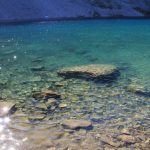Traditional Teachings from Moose Nose Soup
| () |
Travelling down the Yellowhead Highway, I cross the continental divide, leaving the Pacific watershed and entering the Arctic. As I follow the mighty Athabasca into Central Alberta, historic trading posts are scattered between energy extraction projects, a melding of historic and current evidence of our dependence on the land. The Upper and Central Athabasca watersheds are an important link between the Rocky Mountain, Foothills and Boreal forest and are home to grizzly bear, wolverine and other species at risk.
I’m on my way to teach a course on how to use CABIN (Canadian Aquatic Biomonitoring Network), a protocol developed by Environment Canada to assess the health of freshwater ecosystems. Just a few years earlier, I made this same trip to train the Keepers of the Athabasca in the protocol. The Keepers are a cross-cultural community-based group determined to protect their watershed. Equipped with CABIN, the Keepers were able to begin monitoring the effects of a 670-million-litre coal mine waste spill into the upper tributaries of the Athabasca River.
And now we are partnering to train a group from the Alexis Nakota Sioux Nation. Our Upper Athabasca Biomonitoring Program is expanding to 12 CABIN monitoring sites this year, and trained, committed and passionate CABIN volunteers are essential to the success of the program. The first day of training begins with an engaged, enthusiastic group. Cracking jokes, telling stories of life on the river and in the bush, they are as excited as I am to check out the macroinvertebrates that help us to assess stream health. The group is impressed by the holistic approach of the protocol, and make independently leading my first CABIN training course a real joy.
 On the second day of training, I receive a phone call from some of the participants, letting me know they will be late due to a moose being hit on the highway. The participants collected the moose nose, in which I later learned is used for ceremonial moose nose soup, and investigated whether the meat was still edible. I am continuously blown away by this group’s connection to the land and surroundings, their ways of knowing, and constant reminders of the importance of a holistic approach to freshwater monitoring. As I share my scientific methods with them, they give me just as much training into the importance of including traditional ecological knowledge into the protocol.
On the second day of training, I receive a phone call from some of the participants, letting me know they will be late due to a moose being hit on the highway. The participants collected the moose nose, in which I later learned is used for ceremonial moose nose soup, and investigated whether the meat was still edible. I am continuously blown away by this group’s connection to the land and surroundings, their ways of knowing, and constant reminders of the importance of a holistic approach to freshwater monitoring. As I share my scientific methods with them, they give me just as much training into the importance of including traditional ecological knowledge into the protocol.
After the training is complete, we join with the Keepers of the Athabasca and begin monitoring our 12 new sites on the river. As we work, the group’s insights continue to resonate. The importance of indigenous education systems—learning by doing, input from community members and direct learning from elders (mentorship) is imperative for a holistic approach to assess freshwater health. In order to learn about the current state of the ecosystem, like the bugs we collect in the CABIN protocol to determine potential past water quality impacts, we must also investigate the history of a place through community connections, and by accepting of other ways of knowing.





